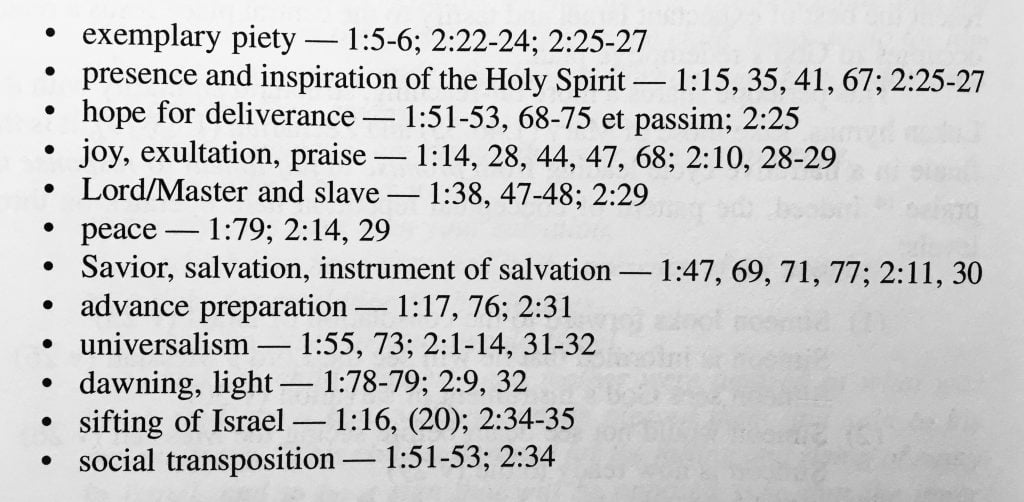 The lectionary reading for Sunday is Luke 2.20–40 as we celebrate the Presentation of Jesus in the temple in Jerusalem. If you are following Luke in the lectionary, this will feel slightly odd; last week we heard about the beginning of Jesus’ teaching ministry in the synagogue in Nazareth, and have already reflected on the ministry of John the Baptist and Jesus’ own baptism, as well as the miracle in Cana. So this is a step back in the narrative before we move on to the catch of fish in Luke 5 and then loop back again to the temptations of Jesus at the beginning of Lent. It feels a bit like playing gospel narrative hop-scotch!
The lectionary reading for Sunday is Luke 2.20–40 as we celebrate the Presentation of Jesus in the temple in Jerusalem. If you are following Luke in the lectionary, this will feel slightly odd; last week we heard about the beginning of Jesus’ teaching ministry in the synagogue in Nazareth, and have already reflected on the ministry of John the Baptist and Jesus’ own baptism, as well as the miracle in Cana. So this is a step back in the narrative before we move on to the catch of fish in Luke 5 and then loop back again to the temptations of Jesus at the beginning of Lent. It feels a bit like playing gospel narrative hop-scotch!
This section in Luke 2 continues Luke’s unique nativity material; Matthew moves straight from the events surround the birth, including the visit of the Magi and the flight to Egypt, to the ministry of John the Baptist. But, in keeping with first-century expectations of a ‘life’ of a significant person, Luke offers (brief) descriptions of Jesus’ upbringing, including the episode in the temple when he is 12 years old.
The narrative once more includes three characteristic emphases of Luke’s work: the importance of Jewish pious devotion as the context for all that happens; the active role of the Spirit in directing events; and the understanding of Jesus as the fulfilment of eschatological hopes.
1. Jewish pious devotion
The whole narrative section begins and ends with an emphasis on pious devotion in fulfilment of the requirements of the law; the ‘requirement of the law of Moses’ in Luke 2.20 is matched by ‘required by the law of the Lord’ in Luke 2.39. We have already been told that Jesus was circumcised (and named) on the eighth day in the previous verse, and now Luke describes two important acts that follow on, the purification of Mary and the dedication of the child, interleaved as chiasm:
A ‘purification rites’
B ‘present him to the Lord’
B’ ‘as it is written… “every male is to be consecrated..”‘
A’ ‘to offer the sacrifice…’
The regulation cited in the outer theme A–A’ is set out in Lev 12.1–8; a woman who has given birth is ceremonially unclean (which, note, has nothing to do with sin) for different lengths of time (depending on whether the child born is a boy or a girl) in this case, for 33 days, so we are a month on from the date of circumcision. It is often noted in preaching that Mary and Joseph offer the more affordable of the two possible sacrifices as a concession to poverty—but in fact Luke makes nothing of this, and the emphasis is not on this, but on their compliance with the requirements set out in the Law. And we need to beware of projecting our own socio-economic framework on a different culture, where even skilled craftsmen might still be not far from subsistence living. Like other aspects of the birth narrative, this doesn’t really suggest that they were particularly poor; it just identifies them as ordinary.
The inner theme of Jesus’ presentation comes from the offering and redemption of the first-born sons (and animals) set out in the Exodus narratives. This offering and redemption appears to have two explanations. The first is in connection with the Passover deliverance itself; in Exodus 13.1–16, the firstborn are to be dedicated to and redeemed from the Lord in parallel with the loss of the firstborn of the Egyptians when the angel of death passes over.
This offering of the firstborn is reiterated in Num 18.14–16, though now in the context of the priestly role of the the tribe of Levi. This goes back to the incident of the Golden Calf in Ex 32; whilst those in the other tribes committed idolatry by bowing down to the calf, the tribe of Levi alone kept themselves pure, so that we read in Num 3.11–12 that the tribe of Levi now has this priestly task.
Originally, God intended that the first-born of each Jewish family would be a kohen – i.e. that family’s representative to the Holy Temple. (Exodus 13:1-2, Exodus 24:5 Rashi)
But then came the incident of the Golden Calf. When Moses came down from Mount Sinai and smashed the tablets, he issued everyone an ultimatum: “Make your choice – either God or the idol.” Only the tribe of Levi came to the side of God. At that point, God decreed that each family’s first-born would forfeit their “kohen” status – and henceforth all the kohanim would come from the tribe of Levi. (Numbers 3:11-12)
What is striking in Luke’s narrative is that, though Jesus is dedicated to the Lord in the temple, he is not redeemed and thus exempted from priestly service. Like Hannah’s dedication of Samuel in 1 Samuel 1.24–28, Jesus remains dedicated to the Lord, which makes the episode in the temple when Jesus is 12 seem to follow on quite naturally. It also signals that Jesus’ ministry will restore to God’s people their priestly role, an idea that is picked up in Revelation as one of its points of connecting with Luke’s gospel. In Rev 1.5–6, Jesus is the one who has ‘freed us from our sins’ and ‘made us to be a kingdom and priests’ to serve God, taking up the pre-Golden-Calf language of Ex 19.6. In Rev 7.3, God’s people are sealed on their foreheads with the seal of the living God, which turns out in Rev 14.1 to be the name of the lamb and God, and by Rev 22.4 this turns out to be the high-priestly adornment as they do priestly service in the presence of God in the New Jerusalem which is shaped as a cube like a giant Holy of Holies.
The integration of these two rites serves to emphasise Mary and Joseph as pious observant Jews, which has two effects. First, it undoes the common claim that Jesus welcomed the outsider, but rebuked the religious; throughout Luke it is both the religiously observant and the ‘sinner’ who hears the good news. Second, it contributes to a consistent assertion that God honours the devotion of his people, a theme continued in Acts as the early followers of Jesus continue to worship in the temple.
2. The role of the Holy Spirit
The emphasis on pious devotion is interweaved in this passage with the importance of the role of the Spirit, just as it has already been in the case of Mary (humbly devoted and then clothed with the Spirit and power) and will be in Jesus’ temptations (disciplined obedience which leads to being filled with the power of the Spirit).
Simeon is ‘righteous and devout’ (dikaios kai eulabes); the term for ‘devout’ here only occurs in Luke’s writings (Acts 2.5, 8.2 and 22.12) but its cognates also occur in Heb 5.7, 11.7 and 12.28 to describe Jesus, Noah and the gathered followers of Jesus in worship. Although the ‘righteous’ are contrasted with the ‘sinners’ Jesus has come to call to repentance, it is clear in Luke (and especially in Matthew) that being ‘righteous’ is a positive quality to be desired and pursued. But along with this, there is a threefold emphasis on the Spirit: the Spirit is ‘upon him’; the Spirit has ‘revealed to him’ that he will see the Messiah; and the Spirit ‘moves him’ to go to the temple at that moment. It is safe to assume that the Spirit has also moved him, like Mary and Zechariah before him, to utter a prophetic oracle often now known by its opening line in Latin translation, the Nunc Dimittis (‘Now you dismiss…’). Given the juxtaposition of pious devotion and the Spirit, it seems fitting that Simeon’s prophetic utterances now finds its place in Anglican pious devotion as part of Night Prayer.
The description of the prophetess Anna provides a parallel with the description of Simeon, as one of Luke’s many male-female pairs. Her pious devotion is expressed in narrative terms, as she prays and fasts in the temple in her widowhood. The detail on fasting reflects a special interest of Luke; he offers us detail that the other gospels omit, namely that Jewish devotion involved ‘frequent’ fasting (Luke 5.33), and that this took place on two days a week (Luke 18.12) which we know from the Didache happened to be Mondays and Thursdays. Luke makes much of meals and eating, as symbolising messianic rejoicing; as its converse, fasting symbolises both sorry for sin and exile, and a longing for the messiah to come. Thus here is is connected with Anna’s anticipation of the ‘redemption of Jerusalem’ (the city serving as a metonym for the whole nation). Luke doesn’t mention the Spirit explicitly in relation to Anna, but like Simeon she offers a prophetic comment on the child.
We might say that, for Luke, the disciplines of pious devotion form the vessel into which he pours his Spirit, and without the Spirit such a vessel is empty. On the other hand, the work of the Spirit issues in these devotions of discipline, and without such disciplines the work of the Spirit is incomplete.
3. The fulfilment of God’s promise
The statements of both Simeon (recorded in detail) and Anna (offered in summary) are saturated with the theme of the eschatological fulfilment of the promise of God, as have (in their different ways) the first two of the three canticles in this part of the gospel. This theme will be repeated again in both the ministry of John the Baptist and the teaching of Jesus in Nazareth. There are some important things worth noting about the nature of this fulfilment.
First, Simeon follows Mary in seeing God’s promises already fulfilled in the person of Jesus. Where Zachariah, in the Benedictus, retains a future sense, Simeon (with the Magnificat) uses the language of realised salvation. Even though all that was promised has not yet happened, the confidence in the person of Jesus is such that it is as if we already have all the answers to the hopes that we longed for.
Second, this fulfilment is rooted in Scripture. Every line of the Nunc Dimittis echoes one of the promises in Isaiah 40–66.
And the glory of the LORD will be revealed, and all people will see it together. (Is 40.5)
I will keep you and will make you to be a covenant for the people and a light for the Gentiles. (Is 42.6)
Arise, shine, for your light has come, and the glory of the LORD rises upon you. (Is 60.1)
(See also Is 46.13, 49.6, 52.10 and 56.1).
Thirdly, this biblical pattern of promise is also personally fulfilled. Just as God has promised something to his people, which he now fulfils in Jesus, so God has promised something to Simeon (that he will not die…) which he now fulfils in Simeon’s encounter with Jesus (…until he has seen with his own eyes). The Spirit of God in Simeon has brought the word of God to Simeon, just as the Spirit has brought the word of God to his people in scripture.
Fourth, all these announcements are marked by joy and wonder, as have all the events around Jesus’ birth, both for those bringing the word of disclosure and for those who hear those words. The theme of joy continues to be a significant part of Luke’s account, both in the gospel and in Acts.
Fifth, and in some contrast, they also include warnings of division and pain. This will affect both the nation (‘the rising and falling of many’, Luke 2.34) and the individuals involved, especially Mary herself. The ‘sword that pierces her heart’ (Luke 2.35) might refer to the demotion of Mary in importance for Jesus as she takes second place to the imperative of gospel ministry, but it surely reaches its clearest fulfilment in her witnessing her son’s excruciating death on the cross.
Joel Green, in his NIC commentary on Luke, notes the wide number of themes in this short passage which interconnect with themes already present from the beginning of the third gospel.
There is much to learn from the individuals in the narrative, but if we are going to focus on the most important thing in preaching (not what we must do but what God has already done) we might note in this passage that God honours pious devotion, God sends his Spirit to guide, reveal and speak, and God fulfils all his promises in the person of Jesus.
Follow me on Twitter @psephizo. Like my page on Facebook.
Much of my work is done on a freelance basis. If you have valued this post, would you consider donating £1.20 a month to support the production of this blog?





























Thanks for this reflection. I have been wondering what the presentation was really all about. The redemption of the firstborn was supposed to take place after 30 days. Also according to Raymond Brown that at in 1st century this was did not require them to go to the Temple. It was simply a payment to the priests.
If the child was of a priestly family then redemption was not required as they would serve as a priest. Did this require some ceremony of presentation? We know Mary’s cousin was married to a priestly and when we looked at the wedding at Cana there was some thought that Mary could have been of a priestly family – did this change things?
I note no mention of the 5 Shekels – had this be paid at 30 days without ceremony?
Thank you for all this. I really liked your commentary with the scripture references.
Where does this picture of the Presentation come from?
God bless
Marielen
Thanks! I don’t remember, but you can find it by doing a ‘reverse image search’ on Google.
How do you do a ‘reverse image search’ on Google?
Go to the Google search page, click on the camera image, and upload the image.
Sorry it didn’t work; “unknown” picture!
By Fra Bartolomeo in 1516. https://en.wikipedia.org/wiki/Presentation_of_Christ_in_the_Temple_(Fra_Bartolomeo)